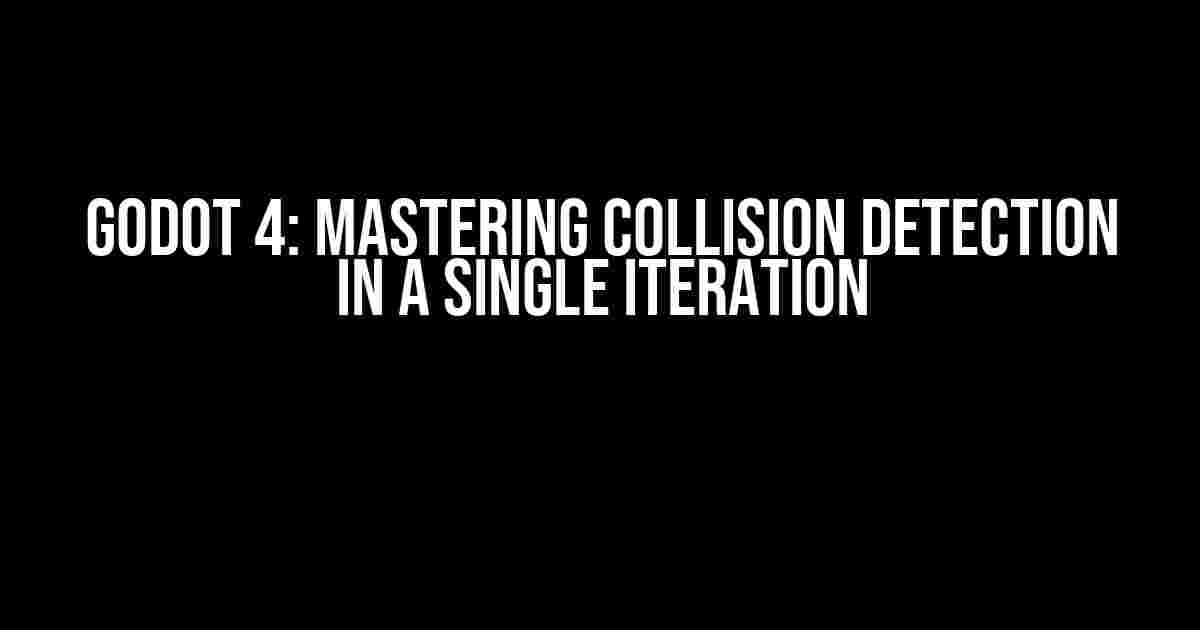Welcome to the world of Godot 4, where collision detection can be a daunting task, especially when you’re trying to detect collisions in a single iteration. But fear not, dear developer, for we’re about to embark on a journey to tackle this challenge head-on. In this article, we’ll delve into the world of Godot 4’s collision detection system and explore the most efficient ways to detect collisions in a single iteration.
Understanding Godot 4’s Collision Detection System
Before we dive into the nitty-gritty of collision detection, it’s essential to understand how Godot 4’s collision detection system works. In Godot 4, collision detection is handled by the physics engine, which uses a combination of algorithms to detect collisions between objects.
There are three main components involved in Godot 4’s collision detection system:
- Collision Shapes: These are the shapes that define the boundaries of an object’s collision area. Examples include spheres, boxes, and capsules.
- Collision Objects: These are the objects that contain one or more collision shapes. Examples include KinematicBody, StaticBody, and RigidBody.
- Physics Engine: This is the core component responsible for detecting collisions between collision objects.
The Challenge of Single Iteration Collision Detection
Now that we have a basic understanding of Godot 4’s collision detection system, let’s talk about the challenge of detecting collisions in a single iteration. In many cases, you might want to detect collisions only during the first iteration, perhaps to trigger an event or perform a specific action.
The problem is that Godot 4’s physics engine runs multiple iterations to ensure accurate collision detection. This means that by default, collisions are detected multiple times, which can lead to undesired behavior or performance issues.
Solution 1: Using the `connect` Method
One way to detect collisions in a single iteration is to use the `connect` method. This method allows you to connect a signal to a specific function, which will be called when the signal is emitted.
In the case of collision detection, you can connect the `body_entered` signal to a function that will be called only once, during the first iteration.
extends KinematicBody
func _ready():
connect("body_entered", self, "_on_body_entered")
func _on_body_entered(body):
print("Collision detected!")
# Perform your desired action here
Solution 2: Using a Flag System
Another approach to detect collisions in a single iteration is to use a flag system. This involves setting a flag when a collision is detected and checking for the flag in subsequent iterations.
Here’s an example:
extends KinematicBody
var collision_detected = false
func _physics_process(delta):
if not collision_detected:
for body in get_overlapping_bodies():
if body.is_in_group("Obstacles"):
print("Collision detected!")
collision_detected = true
# Perform your desired action here
break
Solution 3: Using a Timer
A third approach is to use a timer to detect collisions in a single iteration. This involves setting a timer when a collision is detected and checking for collisions within a specific time frame.
Here’s an example:
extends KinematicBody
var collision_timer = Timer.new()
func _ready():
add_child(collision_timer)
collision_timer.wait_time = 0.1
collision_timer.connect("timeout", self, "_on_collision_timer_timeout")
func _physics_process(delta):
for body in get_overlapping_bodies():
if body.is_in_group("Obstacles"):
print("Collision detected!")
collision_timer.start()
# Perform your desired action here
break
func _on_collision_timer_timeout():
# Reset the timer to prevent multiple collisions
collision_timer.stop()
Best Practices for Single Iteration Collision Detection
When using any of the above solutions, it’s essential to follow best practices to ensure accurate and efficient collision detection:
- Use a specific group or layer for collision objects: This helps to filter out unwanted collisions and improves performance.
- Optimize your collision shapes: Use the most efficient collision shape for your object, and avoid using complex shapes with multiple vertices.
- Use a low-poly collision mesh: If you’re using a mesh-based collision shape, use a low-poly version to reduce the number of vertices and improve performance.
- Avoid using multiple collision objects: Try to use a single collision object per node to reduce the number of collision checks and improve performance.
Conclusion
In this article, we’ve explored the world of Godot 4’s collision detection system and provided three solutions for detecting collisions in a single iteration. By using the `connect` method, a flag system, or a timer, you can efficiently detect collisions and trigger specific actions or events.
Remember to follow best practices to ensure accurate and efficient collision detection, and don’t hesitate to experiment with different approaches to find the one that works best for your project.
| Solution | Description |
|---|---|
| Using the `connect` method | Connects the `body_entered` signal to a function to detect collisions in a single iteration. |
| Using a flag system | Sets a flag when a collision is detected and checks for the flag in subsequent iterations. |
| Using a timer | Sets a timer when a collision is detected and checks for collisions within a specific time frame. |
With these solutions and best practices in mind, you’ll be well on your way to mastering collision detection in Godot 4 and creating engaging, interactive experiences for your players.
Frequently Asked Question
Get ready to unravel the mysteries of Godot 4 collision detection!
How do I detect collisions only on the first iteration in Godot 4?
You can use the `connect` signal in Godot 4 to detect collisions. However, if you want to detect collisions only on the first iteration, you can set a flag to `true` when the collision is detected, and then reset it to `false` after the first iteration. For example: `connect(“body_entered”, self, “_on_body_entered”);` and then in the `_on_body_entered` function, `if not collision_detected: do_something(); collision_detected = true`.
What’s the best way to reset the collision detection flag after the first iteration?
You can use a `Timer` node to reset the collision detection flag after a short delay. For example, you can create a `Timer` node, set its `wait_time` to 0.1 seconds, and then connect its `timeout` signal to a function that resets the flag. This way, the flag will be reset after the first iteration, and collisions will not be detected again until the next iteration.
Can I use a boolean flag to detect collisions only on the first iteration?
Yes, you can use a boolean flag to detect collisions only on the first iteration. For example, you can declare a boolean variable `first_collision = true` and then in the `_on_body_entered` function, `if first_collision: do_something(); first_collision = false`. This way, the code inside the `if` statement will only run on the first collision.
How do I ignore subsequent collisions after the first iteration?
You can use a boolean flag to ignore subsequent collisions after the first iteration. For example, you can declare a boolean variable ` collision_detected = false` and then in the `_on_body_entered` function, `if not collision_detected: do_something(); collision_detected = true`. This way, the code inside the `if` statement will only run on the first collision, and subsequent collisions will be ignored.
What are some common use cases for detecting collisions only on the first iteration in Godot 4?
Some common use cases for detecting collisions only on the first iteration in Godot 4 include: scoring points when a player collects a power-up, triggering a one-time effect when a player collides with an enemy, or activating a script only once when a player enters a specific area.


